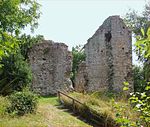East Sutton
Borough of MaidstoneCivil parishes in KentKent geography stubs

East Sutton is a parish approximately 6 miles south-east of Maidstone in Kent, England. East Sutton is small in number of dwellings but relatively large in area: the parish has a women's prison, a council estate of 16 houses and the Grade I listed 13th-century St Peter's and St Paul's Church. The population is included in the civil parish of Sutton Valence. HMP East Sutton Park is a prison and Young Offenders Institution for females, situated in a manor house, located just outside the village. King Edward VII used to visit the village for liaisons with his mistress, Alice Keppel at Pleasure House, on the border with Sutton Valence.
Excerpt from the Wikipedia article East Sutton (License: CC BY-SA 3.0, Authors, Images).East Sutton
Church Lane,
Geographical coordinates (GPS) Address Nearby Places Show on map
Geographical coordinates (GPS)
| Latitude | Longitude |
|---|---|
| N 51.21583 ° | E 0.61583 ° |
Address
Church Lane
ME17 3DE
England, United Kingdom
Open on Google Maps





